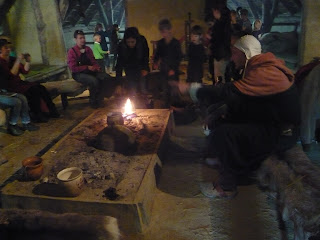It is All Hallows Eve; a time for witches, dressing up and apple bobbing. The Historich Openlucht Museum(open air History Park) is on the outskirts of the Company town of Eindhoven, originally built to house the workers employed in the Phillips Electrical business.
The park is a medieval time slip. As you enter you approach the Bronte Os (Multicoloured Ox) Inn and nearby a set of human sized wooden scales loom invitingly and hinder your further progress. Beside them a medievally attired matron rolls balls of clay into weights. Her scribe is poised with his quill and ink waiting to record judgement. Could you be guilty of witchcraft? The scales do not lie.
The park contains reconstructed buildings from the iron age and the medieval period. I visited on Friday and felt as if I had been dropped into a Medieval world.
From Holland, through Europe right into the heart of Britain wichcraft was a real living force feared by some but indulged by others.
Medieval Eindhoven had its share of witches. The History Park has reconstructed buildings in archeological and architectural detail using the same building techniques as were used centuries ago. There are several iron age farms and medieval halls, a smithy, a weaving shed, shops, boats including a great Viking ship, a grave yard, chapel, a kitchen garden and a number of examples of medieval loos. See some below.
I particularly liked the sheep farm from circa 500BC, the Noble farm-house from 950 AD, the weaver's house approximately 1250 AD and the Inn from circa 1560.
In walking the wooded pathways with their twists and turns, you stumble upon rune stones dangling on twine from the branches of overhanging trees. There is a tangible air of mystery. The spell is obviously taking. Some Dutch witcherey must be afoot.
Beyond the runes on the edge of the wood, a rude tent stitched together from recycled canvas strains to provide protection to the sacred spiral walk carved on the sward below. Friendly helpers (one is pictured below so you'll recognise them for what they do should you ever bump into one) reassure you that the witches will eventually be hunted out and the inhabitants of Medieval Eindhoven will be safe from their spells. They offer you a soothing decoction to soothe your rising (gulp) fear.
Reassured for the moment that I am protected from any itinerant witches, I enter the Noble House, a tenth century Viking hall. People are gathered around the raised hearth, dipping string into a bubbling cauldron of wax, and over the course of repeated dipping they create their own rudimentary candles. The atmosphere is warm and friendly. There is a fine air of good humour about the huge hall. The woven willow shutters, the hand dyed fabrics and wooden chests would have impressed followers of the Arts and Crafts movement many centuries later. Before I could leave, my new found medieval Dutch friends insisted that I undergo trial by scales. They led me from the hall to the market place.
The Viking Hall and ship
Enter the Viking Hall
The clothing chest
The Iron Age Farmstead House
Iron Age Grain Store
Inside the Iron Age farmstead
Thus, I sat on the dubious scales. The lady who had earlier been fashioning weights from clay now began piling them on the opposing scale. Was there now a malicious light in her suddenly beady appearing eyes?My life was hanging in the balance. The ricktety wood frame shuddered, but dear reader the balance lifted not. Apparently my embonpoint, such as it is, was enough to ensure I lacked the necessary airiness to guarantee broomstick liftoff. I signed my certificate of innocence, with the proffered quill and walked away, reluctantly headed back to the real world.
Happy All Hallows Eve to all.





















